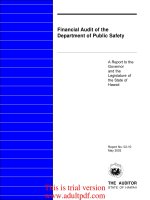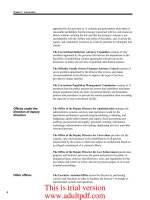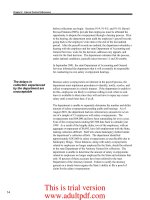Financial Audit of the Hawaiÿi Youth Correctional Facility A Report to the Governor and the Legislature of the State of Hawai‘i Report No. 07-01 January 2007 _part1 doc
Bạn đang xem bản rút gọn của tài liệu. Xem và tải ngay bản đầy đủ của tài liệu tại đây (167.44 KB, 10 trang )
Financial Audit of the Hawaiÿi
Youth Correctional Facility
A Report to the
Governor
and the
Legislature of
the State of
Hawai‘i
THE AUDITOR
STATE OF HAWAI‘I
Report No. 07-01
January 2007
This is trial version
www.adultpdf.com
The Auditor State of Hawai‘i
OVERVIEW
Financial Audit of the Hawaiÿi Youth Correctional Facility
Report No. 07-01, January 2007
Summary
Recommendations
and Response
The Legislature initiated a financial and operational audit of the Hawaiÿi Youth
Correctional Facility through Act 1, Session Laws of Hawaiÿi 2006. The operational
audit of the facility was previously conducted and issued during May 2006 as
Report No. 06-03, Management Audit of the Hawaiÿi Youth Correctional Facility.
This financial audit was conducted by the Office of the Auditor and the certified
public accounting firm of Grant Thornton LLP. We assessed selected fiscal issues
of the Office of Youth Services and the Hawaiÿi Youth Correctional Facility,
including, but not limited to, a review of sick leave, overtime, ward trust accounts,
and procurement issues. The Office of Youth Services is responsible for leading
the State’s services to at-risk youths. The youth correctional facility is a branch of
the Office of Youth Services.
Our audit found that the facility incurs significant overtime costs and sick leave
usage among its youth corrections officers (YCOs). For example, for the 20
YCOs’ payroll histories that we reviewed, an average of 35 percent of their gross
compensation was earned through overtime during FY2004-05. In fact, one YCO
earned $44,845 in overtime compensation as compared to $36,494 in base pay. We
also reviewed the sick leave patterns for these YCOs, noting they took an average
of 164 hours of sick leave and 234 hours of compensatory time off in lieu of sick
leave during FY2004-05. However, we found that high vacancy levels among the
facility’s YCOs and the inherently stressful nature of the work were the primary
drivers of overtime costs and sick leave usage.
We also found that internal controls over the collection of salary overpayments
could be improved; controls over processing, disbursing, and reporting of wards’
trust accounts should be strengthened; and improved compliance with procurement
laws and rules is needed.
We recommended that the facility develop and implement a formal system of
monitoring overtime and sick leave usage among all employees concurrently to
identify any patterns of abuse. The facility should also work with the Office of
Youth Services to fill vacant youth corrections officers positions as soon as
possible. We also made a number of recommendations to the Hawaiÿi Youth
Correctional Facility and the Office of Youth Services regarding monitoring salary
overpayments, handling of wards’ trust accounts, and complying with procurement
laws and rules.
This is trial version
www.adultpdf.com
Report No. 07-01 January 2007
Marion M. Higa Office of the Auditor
State Auditor 465 South King Street, Room 500
State of Hawai‘i Honolulu, Hawai‘i 96813
(808) 587-0800
FAX (808) 587-0830
The Office of Youth Services agreed with our findings and expressed appreciation
for the professionalism and courtesy afforded by our staff and Grant Thornton
LLP. The office provided details of corrective actions being taken or already
implemented since the conclusion of our audit fieldwork.
This is trial version
www.adultpdf.com
Financial Audit of the Hawaiÿi
Youth Correctional Facility
Report No. 07-01
January 2007
A Report to the
Governor
and the
Legislature of
the State of
Hawai‘i
Conducted by
The Auditor
State of Hawai‘i
and
Grant Thornton LLP
THE AUDITOR
STATE OF HAWAI‘I
Submitted by
This is trial version
www.adultpdf.com
Foreword
This is a report of the financial audit of the Hawaiÿi Youth Correctional
Facility, for the fiscal year July 1, 2004 to June 30, 2005. The audit was
conducted in response to Act 1, Session Laws of Hawaiÿi 2006, which
requested the State Auditor to conduct a financial and operational audit
of the facility. The operational audit of the facility was previously
conducted and issued during May 2006 as Report No. 06-03,
Management Audit of the Hawaiÿi Youth Correctional Facility. This
financial audit was conducted by the Office of the Auditor and the
certified public accounting firm of Grant Thornton LLP.
We wish to express our appreciation for the cooperation and assistance
extended by the officials and staff of the Department of Human Services,
the Office of Youth Services, and the Hawaiÿi Youth Correctional
Facility.
Marion M. Higa
State Auditor
This is trial version
www.adultpdf.com
v
Table of Contents
Chapter 1 Introduction
Background 1
Objectives 7
Scope and Methodology 7
Chapter 2 HYCF Has Staffing and Internal Control
Deficiencies
Summary of Findings 9
High Vacancies Drive Significant Overtime Costs
and Sick Leave Usage 9
Internal Controls Over the Collection of Salary
Overpayments Could Be Improved 12
Controls Over Processing, Disbursing, and Reporting
of Wards' Trust Acounts Should Be
Strengthened 13
Improved Compliance with Procurement Laws and
Rules Is Needed 15
Response of the Affected Agency 17
List of Exhibits
Exhibit 1.1 Office of Youth Services Organization Chart 3
Exhibit 1.2 Hawaiÿi Youth Correctional Facility Organization
Chart 5
Exhibit 1.3 HMS 503 - Youth Residential Programs Budgets
for FY2004-05 and FY2005-06 6
This is trial version
www.adultpdf.com
1
Chapter 1: Introduction
Chapter 1
Introduction
The Hawaiÿi Youth Correctional Facility, the State’s only institution for
incarcerated juvenile offenders, has been the focus of intense scrutiny
over the past several years. This scrutiny has risen from extensive
research done by the American Civil Liberties Union of Hawaiÿi (ACLU)
and the U.S. Department of Justice (DOJ) and has resulted in lawsuits
filed against the State of Hawaiÿi. In its August 2003 report, the ACLU
found a pattern of egregious conduct and conditions that violate
minimum, constitutional standards. This was followed by the ACLU’s
filing of a class action lawsuit in 2005. The DOJ's August 2005 report
cited the absence of policies and procedures as the cause of the “state of
chaos” at the facility. The DOJ also filed suit, but entered into a
memorandum of agreement that requires the State to remedy conditions
at the facility in three years’ time. In addition, in November 2005, the
Hawaiÿi State Legislature held informational briefings that surfaced
further concerns about the management of the facility.
Significant attention on the Hawaiÿi Youth Correctional Facility
(HYCF) spurred the Legislature to request that the State Auditor
conduct an audit pursuant to Act 1, Session Laws of Hawaiÿi (SLH)
2006. Our office thereby conducted an audit that assessed the
adequacy of the facility’s management and organization and in May
2006 issued the Management Audit of the Hawaiÿi Youth Correctional
Facility, Report No. 06-03. Additionally, we procured the services of
a certified public accounting firm to review selected financial issues of
the facility; however, the consultant was not available to conduct its
audit work simultaneously with our audit of management issues. The
purpose of this report is to present the consultant’s findings related to
the facility’s fiscal matters. Specifically, the consultant reviewed the
policies and procedures, records, and internal controls in place at the
Office of Youth Services and the facility related to sick leave,
overtime, ward trust accounts, and procurement. The Office of Youth
Services (OYS) has the charge of coordinating a broad range of
services and programs for youth-at-risk, including the oversight of the
facility.
In Hawaiÿi, the practice of youth incarceration dates back to the period of
the Hawaiian monarchy. In 1864, on the island of Oÿahu, King
Kamehameha V created the Keoneÿula Reformatory School for boys and
girls in Kapälama, the first juvenile facility of its kind in the islands. In
1903, 75 of the boys were relocated to farmland in Waialeÿe on the North
Background
This is trial version
www.adultpdf.com
2
Chapter 1: Introduction
Shore. Then, in succeeding decades, various types of facilities and
locales were used to house, train, and educate the youths. Finally, in
1961, the boys’ and girls’ operations were combined to form the Hawaiÿi
Youth Correctional Facility now based in Kailua. The facility would later
experience its own series of moves as it went from one agency’s
headship to another. In 1987, the Legislature created a juvenile justice
interdisciplinary committee to study and determine the appropriate
placement of the youth corrections program. The committee report, made
in January 1989, recommended that a youth services agency be created
and attached to the Department of Human Services for administrative
purposes. This recommendation resulted in the enactment of Act 375,
SLH 1989, which created a new office responsible for the management
and operations of the facility and its juvenile parole functions.
The stipulations of Act 375 called for the Office of Youth Services to
assume the leadership role in responding to the needs of youth-at-risk by
developing and insuring a comprehensive continuum of statewide
planning and coordination, maintaining oversight of activities and
services for children and families, and providing responsibility and
accountability for these services. Additionally, the act noted the
importance of a single entity that would serve as a hub that is able to
coordinate a wide range of services and programs in the effort to prevent
delinquency and reduce the incidence of recidivism.
Headed by an executive director, the office comprises three sections:
the Administrative Services Office, the Program Development Office,
and the Hawaiÿi Youth Correctional Facility Branch. The
Administrative Services Office is responsible for fiscal, procurement,
personnel, and technical services for the organization. The Program
Development Office administers, implements, evaluates, and monitors
a broad spectrum of youth services. The Hawaiÿi Youth Correctional
Facility Branch coordinates youth corrections and rehabilitation
services, which is described in the following section. Exhibit 1.1
shows the Office of Youth Services organization chart.
One of the facility’s main goals is to rehabilitate incarcerated youth and
to assist them in the successful transitioning into the community at the
time of their release. The facility offers a variety of counseling,
treatment, and educational services for the youths who are referred to as
wards or commitments. All staff members participate in the effort to
provide guidance and opportunities leading towards positive change in
the behavior of the youth. The Department of Education also provides
educational programs for the wards, including special education.
Organization of the
Hawaiÿi Youth
Correctional Facility
Organization of the
Office of Youth
Services
This is trial version
www.adultpdf.com
3
Chapter 1: Introduction
Executive Director
Program
Development
Office
Hawaii Youth
Correctional
Facility Branch
Project Director
Corrections
Manager II
Secretary III
Administrative
Services Office
Administrative
Technical Services
Officer
Child & Youth
Program
Development
Officer
Exhibit 1.1
Office of Youth Services Organization Chart
Source: Office of Youth Services
Clerical Supervisor
II
Accountant IV
Clerk-Typists II
Account Clerk III
Child & Youth
Specialists IV & V
Corrections
Program Specialist
II
Project Coordinator
(YGRS*)
Program Specialist
(Juvenile Justice)
Clerical
Program Specialist
(YGRS*)
Child & Youth
Specialist IV
Social Service
Professional
*Youth Gang Response System
This is trial version
www.adultpdf.com
4
Chapter 1: Introduction
The facility includes three secure units: the Secure Custody Facility,
which houses high-risk boys; Hoÿokipa Makai, the unit designated for
short-term, low-risk boys; and the Observation and Assessment
building, which provides housing for the girls. During FY2004-05, the
facility admitted 108 new wards who had never been incarcerated
before and did not arrive due to a parole suspension; these
commitments were 80 percent male and 20 percent female. Among the
new wards, 45 percent were short-term commitments (where their
incarceration periods last less than 365 days) and 64 percent were
minority commitments (with incarcerations lasting until the age of 18,
19, or 20 is reached). Fifty-nine wards were committed by the Family
Court’s First Judicial Circuit, 45 from the Second, Third, and Fifth
Circuits of the Family Court, and unknown sources. During FY2004-
05, the average daily population of facility wards numbered 60.
A corrections manager, more commonly referred to as the administrator,
heads the facility. A secretary and a corrections program specialist
report directly to the administrator, as do section heads for health care
services, business services, corrections and social services, and facility
maintenance-related services sections. Several key positions at the
facility are temporarily filled. Exhibit 1.2 illustrates the organization of
the Hawaiÿi Youth Correctional Facility.
The budget for the Office of Youth Services comprises three programs:
HMS 501—Youth Services Administration; HMS 502—Youth Services
Programs; and HMS 503 Youth Residential Programs. The Office of
Youth Services allocates moneys to the Hawaiÿi Youth Correctional
Facility from the approved HMS 503 budget. HMS 503 provides “a
continuum of residential programs and services ranging from secure
custody to non-secure community-based residential programs.” Exhibit
1.3 summarizes the HMS 503-–Youth Residential Programs budgets for
the past two years, as approved by the Legislature in Acts 41, SLH 2004,
and 178, SLH 2005.
In 1986, our Management Audit of the Hawaiÿi Youth Correctional
Facility, Report No. 86-15, assisted the Legislature in assessing the
facility’s role and performance. We found that Hawaiÿi’s youth
corrections policies and practices lacked clarity and consistency and
failed to provide an adequate framework for effective program
management. More specifically, we found that Hawaiÿi’s legislation
created ambiguity in the roles and responsibilities of the three
departments directly involved in providing services at the Hawaiÿi Youth
Correctional Facility. These included the then Departments of Social
Services and Housing, Education, and Health. These departments lacked
Program
appropriations of the
Hawaiÿi Youth
Correctional Facility
Prior audits
This is trial version
www.adultpdf.com









